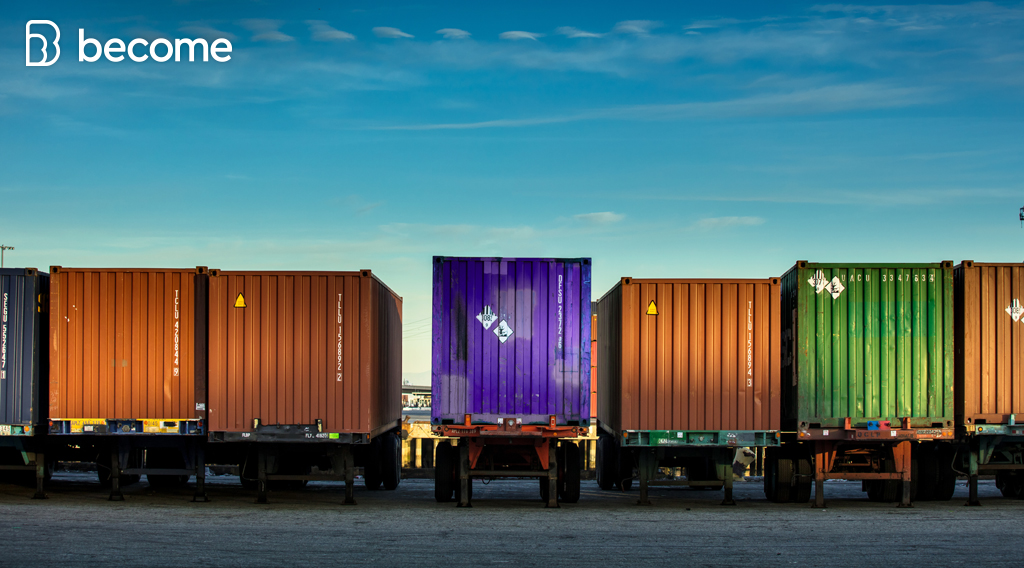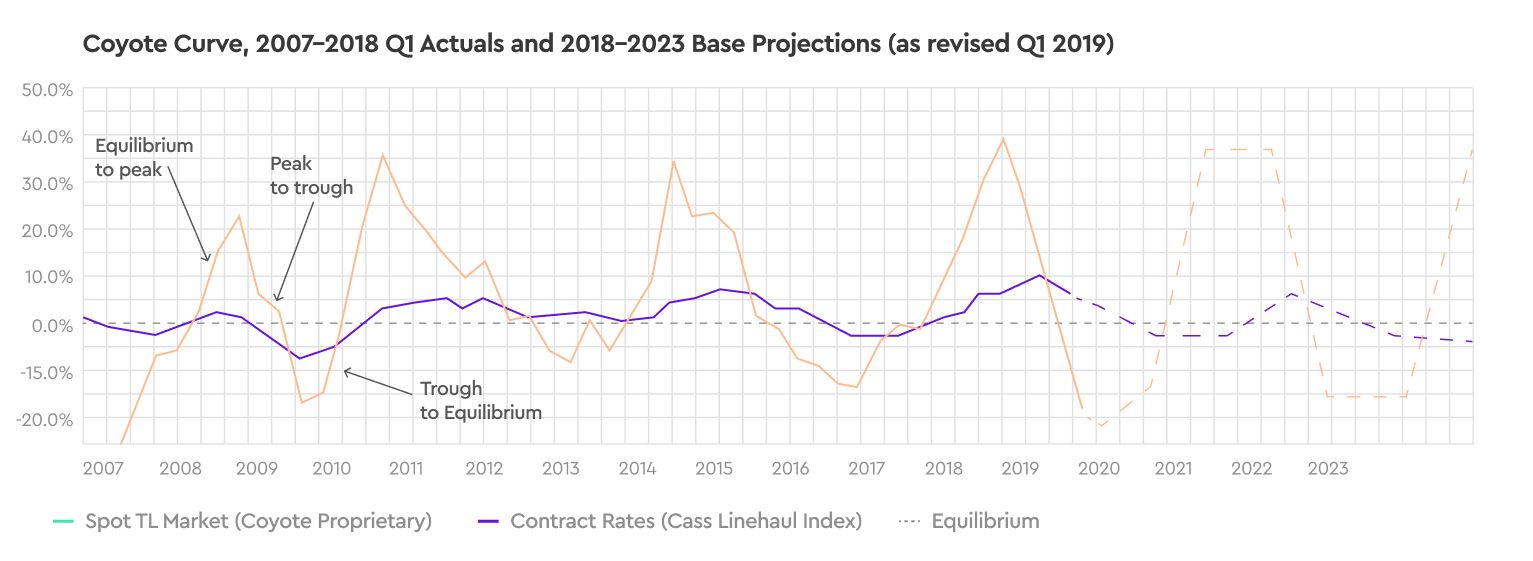
Trucking Industry in 2021: Will The US Freight Market Face a Recession or Recovery?
You don’t need a GPS to figure out where the trucking industry is heading.
What you do need are the insights that you’ll find below, which will shed some light on how we entered a trucking recession to begin with, as well as how we’ll get out of it.
Before we set our sights on the freight rate forecast for 2021, let’s take a glance in the rear-view mirror at how the trucking industry did in 2020. After all, those who don’t learn history are doomed to repeat it!
How did the trucking industry fare in 2019?
2019 came as a bit of a surprise to those working in the freight industry – and the statistics can shed some light on why that is. To be clear, the growing concern in the trucking industry has less to do with the slow performance in 2019 and more to do with how it compares with the strong performance in the preceding years.
To be more specific, during the second quarter of 2019, the GDP Goods Transport Sector grew roughly 0.5%. To put that into perspective, in 2018 the growth rate was 3.2%, and in 2017 it was 5.7%. That might be alarming in-and-of-itself, but according to DAT there were numerous other red flags raised over the wide variety of trucking industry trends that had dropped between 2018 and 2019, for example:
- Spot load posts – Down 10.3%
- Van load-to-truck – Down 19.8%
- Van spot rates – Down 13.5%
- Flatbed load-to-truck – Down 25.6%
- Flatbed spot rates – Down 12.3%
- Reefer load-to-truck – Down 17.3%
- Reefer spot rates – Down 13%
- Fuel prices – Down 9.3%
Talk about throwing a wrench in the works!
With all of those stats in mind it’s important to remember that even though current growth patterns are justifiable cause for concern, trucking businesses are feeling the effects even more because of how well they were doing just a few months prior.
It’s like downgrading from an electric self-driving car to a horse-and-buggy! Okay, maybe not that bad, but you get the point.
Indeed, everything that goes up must eventually come down – and the freight industry is not exempt from that rule. Another indicator that the trucking sector is shifting into lower gears can be seen in the average operating ratios, which are used to determine how much revenue is being allocated toward covering the operating costs.
Operating ratios in the trucking industry are currently averaging over 100%, which means that the average freight business is spending a disproportionate amount of money on its normal business operations. It also means that those companies aren’t earning enough money to pay back their debt or interest (for commercial vehicle loans, for instance).
By this point, you’re probably wondering what’s to blame for these dramatic downturns…
We get to that just below – keep reading!

What caused the slowdown in 2020?
We all want to know what the trucking trends for 2021 will look like. Perhaps the best place to look is back at the road we just traveled. So, what exactly caused the trucking industry to slow down so dramatically in 2020?
The truth is, the blame can’t be placed on any single factor. Several factors came together in 2020 to create something of a ‘perfect storm’ which had the effect of hitting the brakes on the freight industry after it had been moving pedal-to-the-metal in 2018.
The top causes of the 2020 trucking recession are:
- Tariffs – throughout 2018, there were rumblings of new trade wars on the horizon between the U.S. and Mexico, as well as between the U.S. and China. In anticipation of the coming trade tariffs, many trucking businesses scrambled to beat the impending heat by stocking up on inventory. At present, trade tariffs are in effect and have resulted in a marked decline in manufacturing and retail production rates. Naturally, this means less demand for shipping services. Economists estimate that the net loss from trade tariffs would come out to approximately $16.8 billion.
- Overcapacity – freight companies began growing their fleets as freight volumes (and margins) grew in 2018, only to be met in 2019 with daily truckload volumes dropping to 3-4% lower than the year before. Although volumes have recently started to recover, winter is generally regarded as the toughest time for carriers. Only time will tell where the cards will fall.
- Weather – trucking isn’t always a breeze, especially when severe weather patterns are thrown into the equation. A few months ago, headlines were warning the East Coast of the potentially devastating impact of Hurricane Dorian. Trucking companies rushed to prepare their distribution efforts, including the proactive rerouting of shipments and a 30% increase in specific shipments compared to the month before. In hindsight, we know that the effects of Hurricane Dorian were largely concentrated in The Bahamas and the U.S. got off easy.
- Coronavirus – this is pretty self-explanatory. The COVID pandemic affected virtually every industry all around the globe, and trucking was definitely not an exception.
Economic predictions for the trucking industry in 2021
Developing a 100% accurate trucking industry forecast for 2021 is, of course, impossible. But even so, there are predictions about an upcoming bounce-back from the 2019 trucking recession which freight companies should definitely be paying attention to.
There’s one specific predictive tool released last year by Coyote Logistics – known as the Coyote Curve – which forecasts a period of very strong freight industry growth beginning in 2021.
Coyote curve forecasts
The Coyote Curve can be summarized as having three parts to a complete ‘market capacity cycle’:
- Equilibrium (0) to peak
- Peak to trough
- Trough to Equilibrium
Have a look at the chart below, which illustrates the Coyote Curve and defines each of the three parts of a complete market capacity cycle.

At any given point in time, the trucking industry will find itself within one of three ‘phases’ of the Coyote Curve:
|
Inflationary |
Equilibrium |
Deflationary |
|
|
|
Presently, we’re nearing the third part of a complete market capacity cycle – Trough to Equilibrium. That means the trucking recession is coming to an end as freight rates bottom out and begin to climb back up again. While it’s still too early to tell for sure, if the Coyote Curve continues to be as accurate as it’s proven to be thus far, the trucking industry forecast for 2021 looks promising.
Technological trends & predictions for trucking in 2021
As we journey further into the 21st Century, it should come as no surprise that technology will continue to reshape entire industries – the freight industry included. Among the forecasted trucking trends for 2021, there are a handful that paint quite an interesting picture for freight rate forecast for 2021.
Technological Trucking Trends for 2021:
- Blockchain
- Internet of Things (IoT)
- Artificial Intelligence (AI)
- Electronic Logging Device (ELD)
- Fintech
- E-Commerce
1. Blockchain
Blockchain offers trucking companies the ability to share data, documents, and other bits of information through a decentralized system that ensures safety for everyone along the ‘chain’. One of the biggest perks of blockchain is that it also gives everyone in the ‘chain’ the ability to see the information, which they can then use to optimize the supply chain in ways that couldn’t have been done without that level of transparency.
2. Internet of Things (IoT)
The Internet of Things is a way to gather pertinent information from the machines that drive businesses – in this case, trucks. This can help truckers in a wide variety of ways: alert them when the truck needs maintenance, show them real-time performance metrics to keep the truck operating at optimal capacity, and so on.
3. Artificial Intelligence (AI)
When there are mountains of data that manpower simply can’t crunch through quickly enough, artificial intelligence can help. The applications for AI in the trucking industry are virtually limitless, for example: optimizing transfer times from truck-to-truck, accurately track and predict delivery times, ensure that shipments are loaded to the correct trucks, and so on.
4. Electronic Logging Device (ELD)
This addition to a truck’s engine is used to gather information about if the engine is running, if the truck is moving, how far the truck has driven, and how long the engine worked. In other words, the ELD is designed for the purpose of keeping accurate track of driver performance and ensure that legal regulations are being abided.
5. FinTech
It’s no secret that some customers can be notoriously slow to pay their bills, which is why freight factoring exists. Likewise, most trucking business owners are familiar with the expenses involved in obtaining more vehicles, which is why commercial vehicle loans have come to be. There are numerous challenges in the trucking industry – regardless of which one you’re facing, there’s a funding solution that can help you fill up your financial gas tank.
Financial technology (FinTech) is making it faster and easier than ever for trucking business owners to apply for business loans. To add to that, Become offers an array of advantages that freight companies simply won’t find anywhere else, including matching them with the optimal lender and loan type for their specific needs.
Side note: Did you know there are specific loans for trucking companies? If not, be sure to do your research before proceeding with industry loans that might not be an optimal fit for your needs.
6. E-Commerce
While e-Commerce is not exactly a technological trucking trend for 2021, it is a technological trend that truckers should be aware of – if they aren’t already. E-commerce is all about convenience, and as it continues to grow, it will mean the trucking industry will need to develop more efficient ways to handle the emphasis placed on speed-of-delivery.
Rounding the bend
Now that you have a clearer understanding of the trucking industry forecast for 2021, it’s time to make sure you’re steered in the right direction. With the predictions made by the Coyote Curve in mind, you should get yourself ready for a period of growth in the trucking sector – now is time to get your ‘trucks’ in a row!
We’re almost out of this trucking recession, don’t take your foot off the gas now. Stay driven!



 Please wait...
Please wait...




